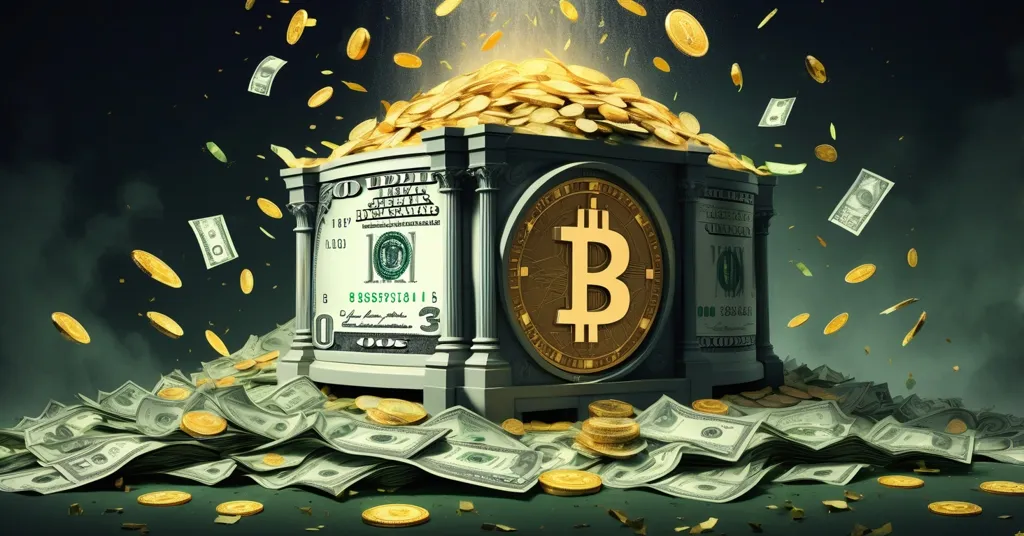Ray Dalio Urges 15% Bitcoin and Gold Allocation Amid $37.7T U.S. Debt Crisis

Ray Dalio’s Stark Warning: Allocate 15% to Bitcoin and Gold as Debt Crisis Looms
Billionaire hedge fund titan Ray Dalio, founder of Bridgewater Associates, has issued a urgent call to action for investors: allocate 15% of portfolios to risk-off assets like Bitcoin and gold. With the U.S. national debt skyrocketing past $37.7 trillion and the UK drowning under £2.87 trillion, Dalio sees these assets as critical hedges against dollar devaluation and macroeconomic collapse. His advice isn’t just a portfolio tweak—it’s a siren for the fiscal storm ahead.
- Major Shift: Dalio pushes for a 15% allocation to Bitcoin and gold, a sharp rise from his 1-2% Bitcoin suggestion in 2022.
- Debt Crisis: U.S. debt exceeds $37.7 trillion; UK debt hits £2.87 trillion with a debt-to-GDP ratio near 100%.
- Dire Forecast: Without deficit cuts, both nations face potential economic ruin within years.
The Debt Abyss: U.S. and UK Fiscal Nightmares
The numbers are staggering and paint a grim picture of fiscal irresponsibility on both sides of the Atlantic. In the U.S., the national debt has ballooned to over $37.7 trillion, a figure that dwarfs historical spikes even from World War II when debt-to-GDP ratios hit their peaks. For context, debt-to-GDP—essentially how much a country owes compared to its total economic output—is now at a crippling 125%. It’s like owing more on your mortgage than your entire yearly salary, except scaled to trillions. The U.S. Treasury projects an additional $1 trillion in debt for Q3 of 2025, with another $590 billion by Q4. Dalio points out the government spends 40% more than it earns, lugging a debt six times its income. Annual interest payments alone? A cool $1 trillion, devouring half the budget deficit. What does this mean for the average Joe? It’s like paying rent on a house you’ll never own—except the landlord is Uncle Sam, and the bill never stops growing. You can explore the full scale of this crisis through detailed U.S. national debt figures.
Dalio predicts the Federal Reserve will have to fire up the money printers to keep this house of cards standing. This process, known as quantitative easing (QE), is when the Fed creates money out of thin air to buy government bonds, flooding the system with liquidity. Sounds like a magic trick, right? Except the side effect is often a devalued dollar and creeping inflation, eroding purchasing power. Dalio’s blunt assessment, shared on Twitter on July 23, 2025, pulls no punches:
The basic picture has not changed — if the US doesn’t cut the deficit to 3% of the GDP, and soon, we risk facing an economic heart attack in the next three years.
While the U.S. grapples with its fiscal black hole, the UK faces a parallel disaster. National debt stands at £2.87 trillion, roughly £58,000 per adult—about the average annual salary for many. The debt-to-GDP ratio hovers near 100%, meaning the country owes as much as it produces in a year. June 2025 borrowing spiked to £20.7 billion, the second-highest on record, with interest charges hitting £16.4 billion in the same month. Dalio’s advice to the UK is brutal but clear: slash the deficit from 5.1% to 3% of GDP through spending cuts and taxation, or face financial meltdown. UK Chancellor Rachel Reeves is caught in a vise, with limited room to maneuver. Economists like Rob Wood from Pantheon Macroeconomics predict harsh measures—think “sin taxes” on booze and smokes, frozen income tax thresholds, or even pension tax grabs—to plug a £30 billion hole. This isn’t just dry data; it’s a crisis shaking investor confidence and pushing capital toward alternative assets. For more on the UK’s fiscal challenges, check this update on UK borrowing under Reeves.
Dalio’s 15% Play: Why Bitcoin and Gold?
So why does Dalio champion Bitcoin and gold for 15% of your portfolio? Both are positioned as store-of-value assets—safe harbors that can shield wealth from currency devaluation and optimize what he calls the return-to-risk ratio, or simply, how much reward you snag for the gamble you take. Gold is the old-school heavyweight, a go-to during economic uncertainty with a track record spanning centuries. When markets panic, gold often shines as investors flee riskier bets. Bitcoin, meanwhile, is the scrappy newcomer, a decentralized digital currency built on blockchain technology. For the uninitiated, blockchain is a tamper-proof ledger spread across a network of computers, free from any central bank or government meddling. Bitcoin’s capped supply of 21 million coins makes it a potential bulwark against inflation, unlike fiat currencies that can be printed ad nauseam. Learn more about how these assets serve as hedges against debt crises.
Dalio’s personal lean is toward gold, especially during high risk aversion, but his inclusion of Bitcoin—up from a measly 1-2% in 2022—signals a growing respect for its role as a hedge. He holds some BTC himself, though he’s candid about its limitations. Laith Khalaf, Head of Investment Analysis at AJ Bell, echoes this caution:
Gold is a much preferable diversifier to Bitcoin, as it tends to increase in price when risk aversion is high. It can be a useful insurance policy for a portfolio, but importantly held alongside shares and bonds to achieve a balance of risk and reward.
Khalaf’s point cuts to a core tension for crypto fans: Bitcoin’s disruptive allure clashes with its unproven grit in true crises. Its price can swing like a pendulum on steroids, a rollercoaster even adrenaline junkies might dodge. Yet Dalio’s nod to BTC reflects a broader shift—more institutional heavyweights are eyeing it as a counterweight to fiat debasement. For insights into his broader thinking, take a look at this report on Dalio’s 15% allocation suggestion.
Bitcoin’s Role: Digital Gold or Wild Card?
Let’s zoom in on Bitcoin’s place in Dalio’s strategy. Its appeal lies in its decentralized nature and scarcity—qualities gold can’t replicate. Unlike any metal, Bitcoin offers censorship resistance and borderless transactions, a middle finger to centralized control. In a world where governments print money like it’s Monopoly cash, BTC’s fixed supply is a beacon of financial sovereignty. Dalio’s jump to a 15% allocation (split between Bitcoin and gold) isn’t just a personal pivot; it mirrors a trend among institutions. Take BlackRock’s foray into Bitcoin ETFs or MicroStrategy’s balance sheet stuffed with BTC—big players are dipping toes into crypto waters, lending it legitimacy as a store of value. Curious about community reactions? See this Reddit discussion on Dalio’s views.
But let’s not drink the Kool-Aid just yet. Bitcoin isn’t flawless. Beyond its notorious volatility, risks loom large—regulatory crackdowns could cripple adoption, and debates over its energy consumption still rage. Gold doesn’t face these headaches; it’s a tangible rock you can stash under your mattress. Dalio’s gold bias might frustrate Bitcoin maximalists, but honestly, BTC doesn’t need to be everything to everyone. Its niche as a decentralized hedge works for specific crises, while altcoins like Ethereum tackle smart contracts and DeFi in ways Bitcoin wasn’t designed for. Dalio skipping altcoins entirely aligns with a purist view: Bitcoin as digital gold, not a speculative tech sandbox. In a debt-fueled mess like this, sticking to semi-proven stores of value beats chasing the latest token hype.
Counterpoints: Is the Panic Overblown?
Before we all rush to stockpile Bitcoin and gold bars, let’s play devil’s advocate. Some economists argue Dalio’s doom-and-gloom forecast overstates the danger. They point to post-2008 recovery as proof that controlled money printing through quantitative easing can stabilize economies without triggering hyperinflation. The Fed pulled off a high-wire act back then, pumping trillions into the system while keeping prices somewhat in check. Why panic now? Couldn’t central banks thread the needle again, balancing debt with strategic liquidity? For more on Dalio’s broader economic predictions, check his track record on financial forecasts.
Here’s the rub: today’s debt levels are a different beast. The U.S. debt-to-GDP ratio is higher than post-WWII peaks, and interest payments alone are a budget-killer. Unlike 2008, we’re also battling sticky inflation and geopolitical shocks—think energy crises or trade tariffs. QE might not spark Weimar-style collapse, but it risks further eroding fiat value, especially with trust in central banks already fraying. Dalio’s “economic heart attack” warning isn’t just fear porn; it’s a reminder that kicking the can down the road has limits. Politicians dithering on deficit cuts aren’t just clueless—they’re playing Russian roulette with the economy. Dive deeper into his stark warnings with this analysis of Dalio’s debt crisis concerns.
What’s Next for Crypto Investors?
Dalio’s 15% call isn’t just investment advice; it’s a flashing neon sign on the fragility of fiat systems. As U.S. and UK deficits spiral, the appeal of decentralized assets grows. Bitcoin’s promise of financial autonomy isn’t a tech gimmick—it’s a potential lifeline. Will more hedge funds follow Dalio’s lead, driving institutional adoption? Recent moves by firms like BlackRock suggest yes, though regulatory hurdles and market jitters could slow the roll. For individual investors, the takeaway is balance: Bitcoin and gold as insurance, not a full pivot from stocks or bonds. Dalio isn’t saying ditch fiat entirely—he’s saying brace for impact. To understand more about his investment philosophy, here’s a detailed profile on Ray Dalio.
That said, governments aren’t likely to swallow the bitter pill of deficit cuts anytime soon. Tax hikes and spending slashes are political poison, especially with sluggish UK growth and rising U.S. inequality. If money printing continues unchecked, devaluation could push even skeptics toward crypto. The question isn’t just about portfolio splits; it’s whether Bitcoin can cement its role as a crisis asset before the next storm hits. For the latest on his strategic recommendations, see this update on Dalio’s 2025 allocation stance.
Key Questions and Takeaways
Why Does Dalio Push for a 15% Allocation to Bitcoin and Gold?
Responding to a U.S. debt crisis over $37.7 trillion and UK debt at £2.87 trillion, Dalio sees these assets as vital hedges against currency devaluation and macroeconomic turmoil.
Why Does Dalio Prefer Gold Over Bitcoin?
He trusts gold’s historical stability during risk-averse periods, while Bitcoin’s volatility and untested status as a reserve currency keep him wary, despite owning some BTC.
How Critical Is the Debt Crisis in Dalio’s Eyes?
Extremely critical—he warns of an “economic heart attack” within three years for the U.S. if deficits aren’t cut to 3% of GDP, with the UK facing similar collapse risks.
Is Bitcoin Now Mainstream for Institutional Portfolios?
Somewhat—Dalio’s endorsement shows growing acceptance, but his gold preference and doubts about Bitcoin’s scalability signal it’s not a full embrace yet.
Should Investors Abandon Fiat for Crypto and Gold?
Not entirely; Dalio stresses balance, using Bitcoin and gold as protective layers alongside traditional assets, not as total replacements for fiat holdings.
Dalio’s warning is a sobering gut check on global finance. The U.S. and UK teeter on fiscal cliffs, and while Bitcoin and gold offer potential shields, they’re not magic fixes. Gold’s reliable but uninspiring; Bitcoin’s groundbreaking but erratic. The real kicker is whether governments will act on deficit cuts or keep conjuring cash until the system implodes. For now, a 15% hedge might be the sanest bet in a world where reality is harder to face than a printing press.



